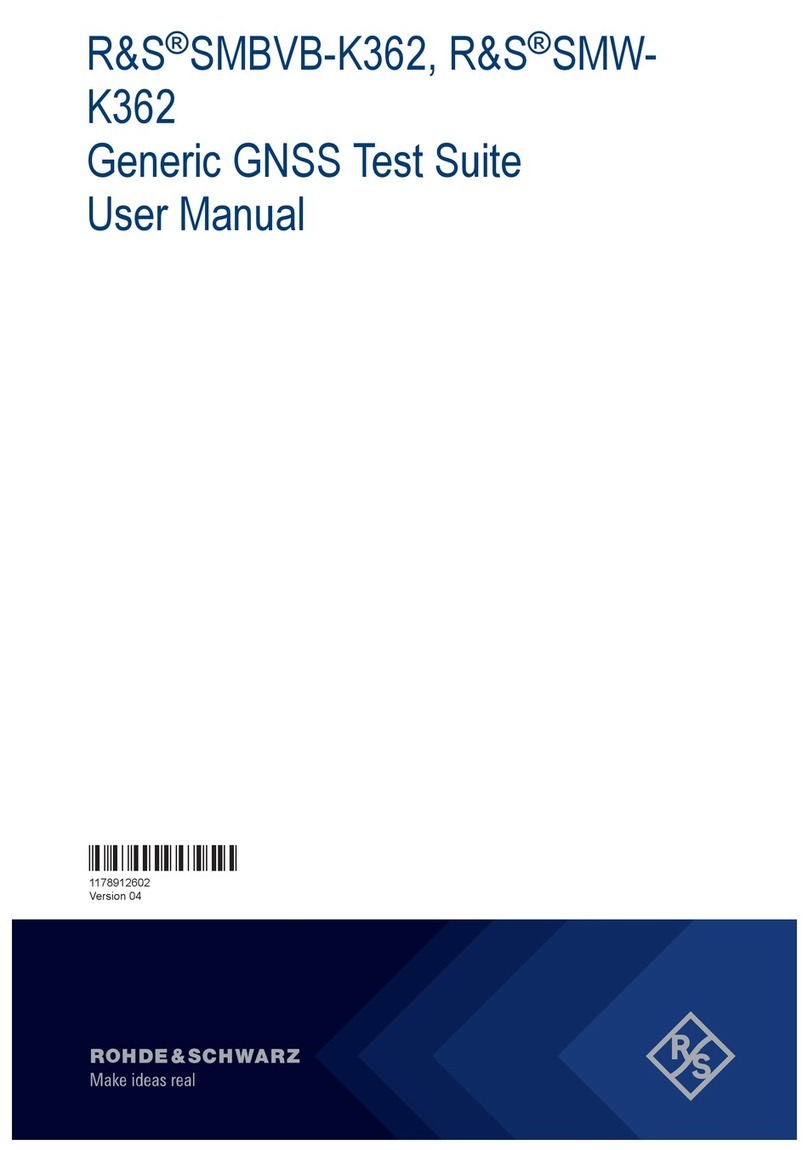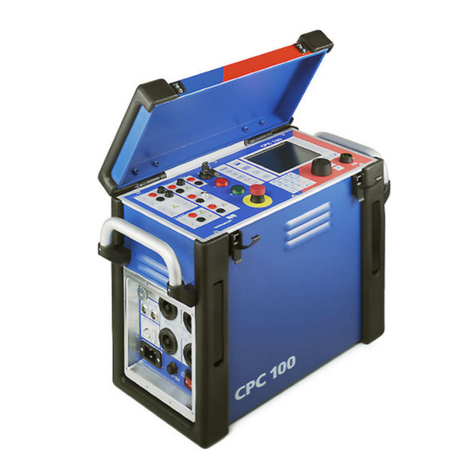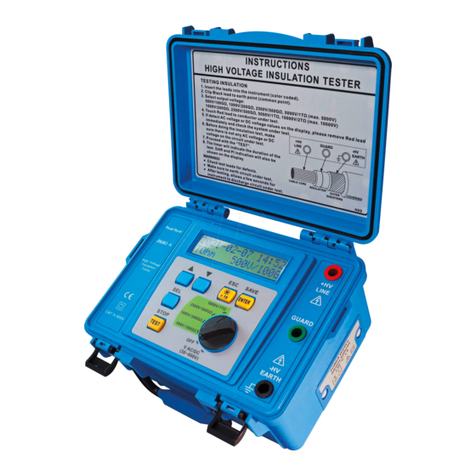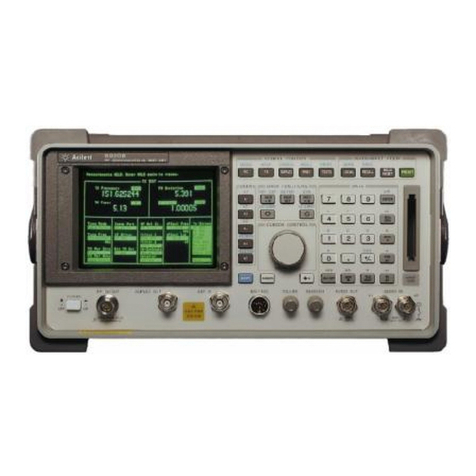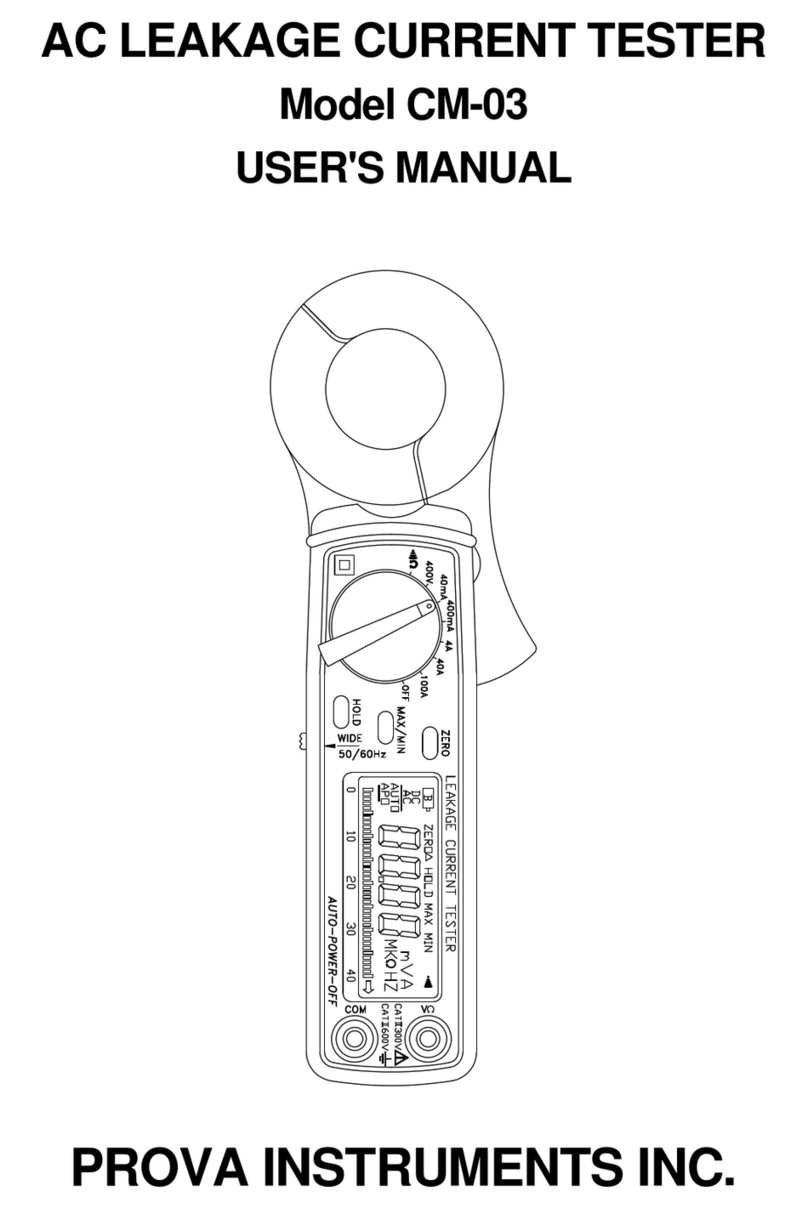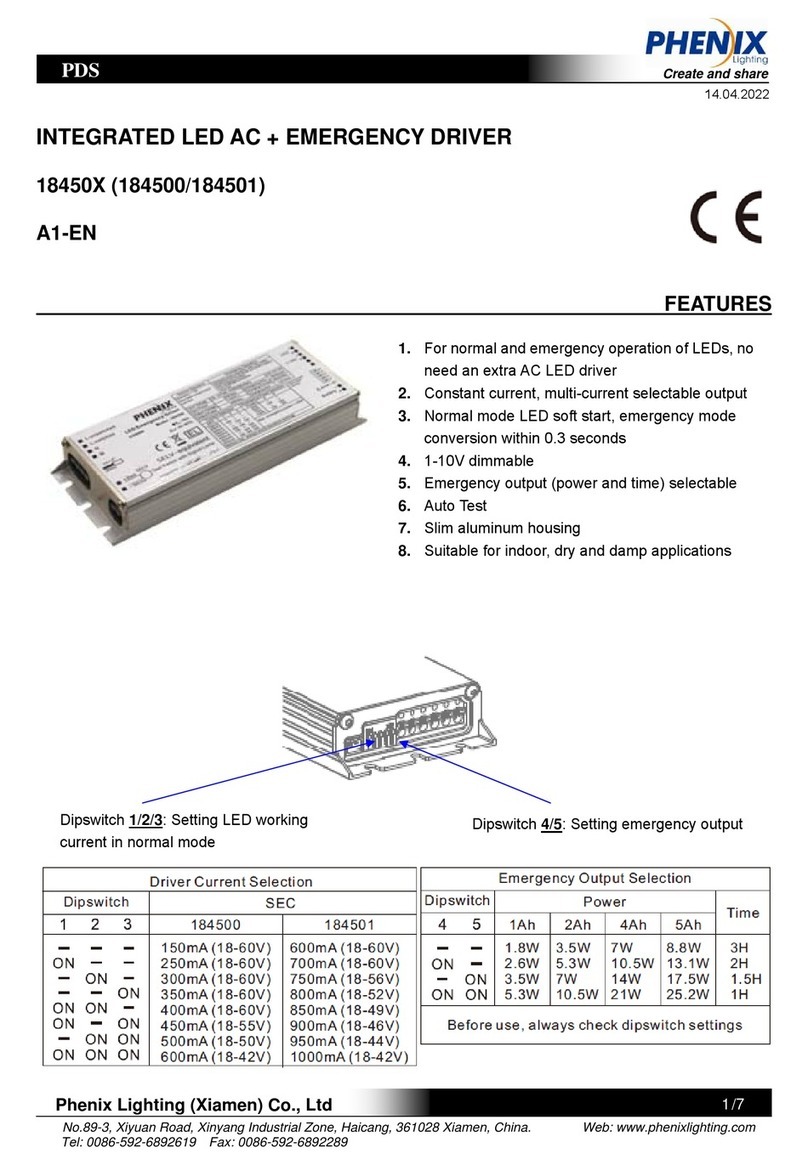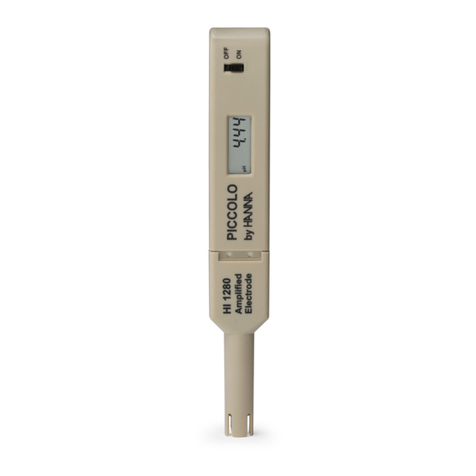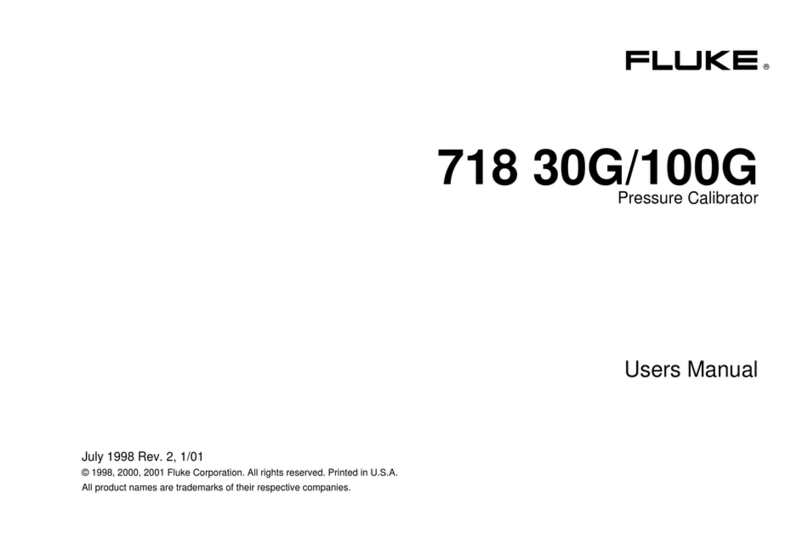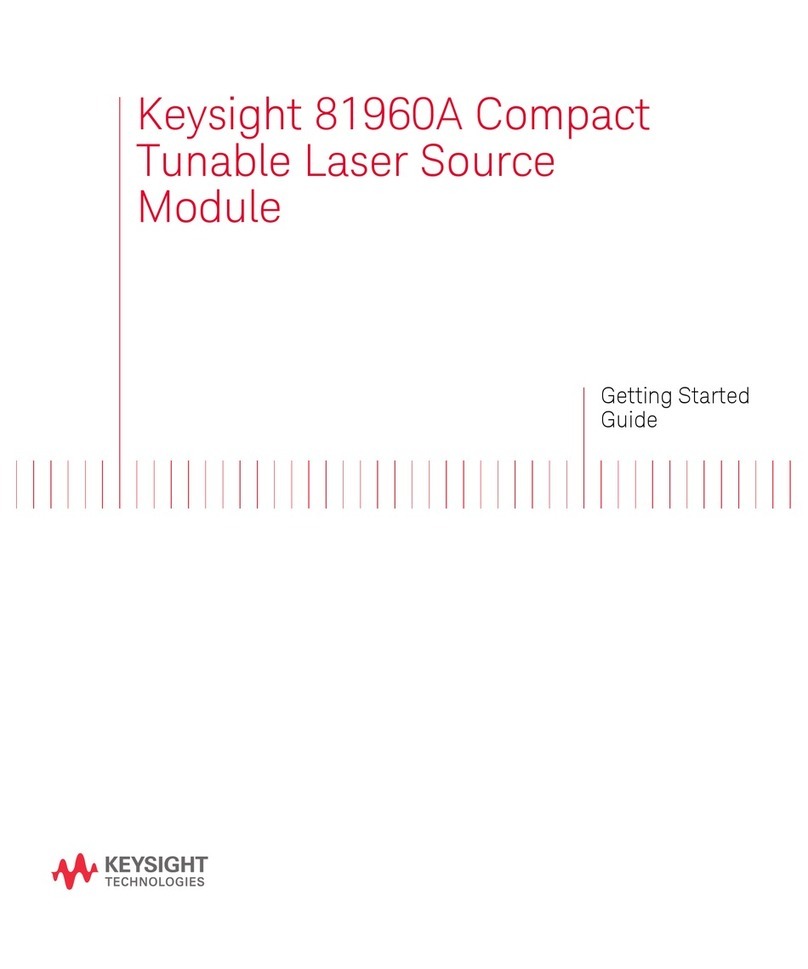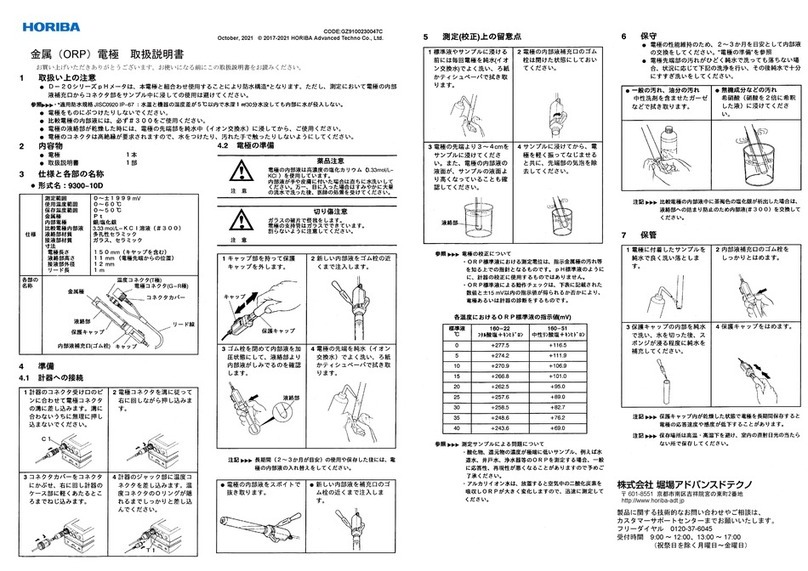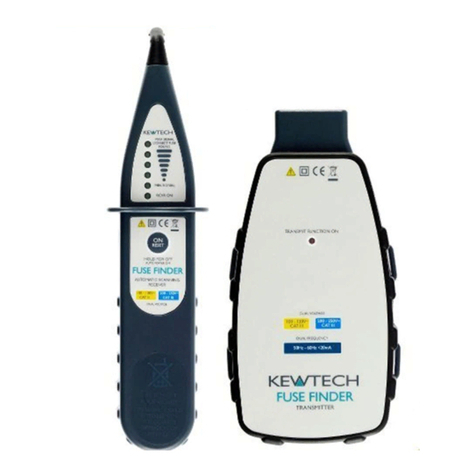Elbro AG DETECTOR 3000 User manual

Detector 3000 Seite 0 / 11 Stand: 29.8.19 GB
CAT III / 1000V
CAT IV / 600V
EN 61326-1
IEC 61243.3:2014
EN Manual
DETECtOR 3000
universaltester
électrotesteur
elettrotester
electrical tester

Detector 3000 Seite 1 / 11 Stand: 29.8.19 GB
1. Opening for current measurement
2. Test leads (on back side)
3. LED display
4. LCD display
5. On/ off and function button
6. Torchlight and hold button
7. Battery compartment
8. Sensor for cable break detection, NCV
1.
2.
3.
4.
5.
6.
7.
8.

Detector 3000 Seite 2 / 11 Stand: 29.8.19 GB
Content
1. Introduction / Product Package
2. Safety Measures
3. Danger of electric shock and other dangers
4. Intended Use
5. Testers Information
6. Preparation for tests
6.1 Auto-power on/ switching on
6.2 Auto-power off
7. Conducting Tests
7.1. Voltage test
7.1.1. Low Voltage mode
7.2. Current Test
7.3. Single-pole phase test
7.4. Phase rotation test
7.5. Continuity test
7.6. Diode test
7.7. Resistance test
7.8. Frequency test
7.9. NCV Test
7.10. Torch light
7.11. Self test
7.12. HOLD Function
7.13. Backlight
8. Battery Replacement
9. Technical Data
10. Cleaning and storage
References marked on tester or in instruction manual:
Warning of a potential danger, comply with instruction manual.
Reference. Please pay utmost attention.
Caution! Dangerous voltage. Danger of electrical shock.
Continuous double or reinforced insulation complies with category II DIN EN 61140.
Conformity symbol, the instrument complies with the valid directives. It complies with the
EMV -Directive (2014/30/EU), Standard EN 61326-1 are fulfilled. It also complies with the Low
Voltage Directive (2014/35/EU), Standard EN61243-3:2014 is fulfilled.
Tester complies with the standard (2012/19/EU) WEEE
The instruction manual contains information and references, necessary for safe operation
and maintenance of the tester.
Prior to using the tester (commissioning/ assembly) the user is kindly requested to thoroughly read
the instruction manual and comply with it in all sections.

Detector 3000 Seite 3 / 11 Stand: 29.8.19 GB
Failure to read the tester manual or to comply with the warnings and references contained
herein can result in serious bodily injury or tester damage.
The respective accident prevention regulations established by the professional associations are to
be strictly enforced at all times
Voltage tester is not a measurement device, it is only allowed to use for testing purposes.
1. Introduction / Product Package
The Detector 3000 is a universally applicable testers for voltage, current, continuity and rotary field
testing and various additional features.
The testers are constructed according to the latest safety regulations and guarantee safe and
reliable working.
It complies with the standard for two pole voltage testers EN61243-3:2014.
The Detector 3000 is characterized by the following features:
●Designed to meet international safety standards. EN61243-3:2014
● Measurement Category (CAT.) IV 600V
● Measurement Category (CAT.) III 1000V
●AC and DC voltage test up to 1000V with LEDs
•Current test up to 200A
●AC voltage test up to 1000V and DC voltage test up to 1500V with LCD
● Cable break tests by Non Contact Voltage detection
● Polarity indication
● Single-pole phase test
● Phase rotation test
● Continuity test
● Resistance measurement
● Frequency measurement
● Vibration motor
● Auto-power ON / OFF
● Torch light
● IP64 protection
After unpacking, check that the instrument is undamaged.
The product package comprises:
1 pc Detector 3000
2 pcs 4mm test tip adapters
2 pcs GS38 rubber caps
2 pcs batteries 1.5V, IEC LR03
1 pc operating instructions

Detector 3000 Seite 4 / 11 Stand: 29.8.19 GB
2. Safety Measures
The testers have been constructed and tested in accordance with the safety regulations for
voltage testers and have left the factory in a safe and perfect condition.
The operating instructions contain information and references required for safe operation
and use of the tester. Before using the tester, read the operating instructions carefully and
follow them in all respects.
Depending on the internal impedance of the voltage tester there will be a different capability
of indicating the presence or absence of operating voltage in case of the presence of
interference voltage.
A voltage tester of relatively low internal impedance, compared to the reference value of
100 kΩ, will not indicate all interference voltages having an original voltage value above the
ELV level. When in contact with the parts to be tested, the voltage tester may discharge
temporarily the interference voltage to a level below the ELV, but it will be back to the
original value when the voltage tester is removed.
When the indication “voltage present” does not appear, it is highly recommended installing
earthing equipment before work.
A voltage tester of relatively high internal impedance, compared to the reference value of
100 kΩ, may not permit to clearly indicate the absence of operating voltage in case of
presence of interference voltage.
When the indication “voltage present” appears on a part that is expected to be
disconnected of the installation, it is highly recommended confirming by another means
(e.g. use of an adequate voltage tester, visual check of the disconnecting point of the
electric circuit, etc.) that there is no operating voltage on the part to be tested and to
conclude that the voltage indicated by the voltage detector is an interference voltage.
A voltage tester declaring two values of internal impedance has passed a performance test
of managing interference voltages and is (within technical limits) able to distinguish
operating voltage from interference voltage and has a means to directly or indirectly
indicate which type of voltage is present.
3. Danger of electric shock and other dangers
To avoid an electric shock, observe the precautions when working with voltages
exceeding 120 V (60 V) DC or 50 V (25 V) eff AC. In accordance with DIN VDE these
values represent the threshold contact voltages (values in brackets refer to limited ranges,
e.g. in agricultural areas).
The tester must not be used with the battery compartment open
Before using the tester, ensure that the test lead and device are in perfect working order.
Look out e.g. for broken cables or leaking batteries.
Hold the tester and accessories by the designated grip areas only, the display elements
must not be covered. Never touch the test probes.
The tester may be used only within the specified measurement ranges and in low-voltage
installations up to 1000VAC and 1500VDC.
The tester may be used only in the measuring circuit category it has been designed for.
Before and after use, always check that the tester is in perfect working order (e.g. on a
known voltage source).

Detector 3000 Seite 5 / 11 Stand: 29.8.19 GB
Make sure that the cables tested for current are double insulated.
The tester must no longer be used if one or more functions fail or if no functionality is
indicated.
It is not permitted to use the tester during rain or precipitation.
A perfect display is guaranteed only within a temperature range of -15°C to +55°C at
relative air humidity less than 85%.
If the safety of the user cannot be guaranteed, the tester must be switched off and secured
against unintentional use.
Safety is no longer guaranteed e.g. in the following cases:
−obvious damage
−broken housing, cracks in housing
−if the tester can no longer perform the required measurements/ tests
−stored for too long in unfavorable conditions
−damaged during transport
−leaking batteries
The tester complies with all EMC regulations. Nevertheless it can happen in rare cases that
electric devices are disturbed by the electrical field of the tester or the tester is disturbed by
electrical devices.
Never use the tester in explosive environment
Tester must be operated by trained users only
Operational safety is no longer guaranteed if the tester is modified or altered.
The tester may be opened by an authorized service technician only.
4. Intended Use
The tester may be used only under the conditions and for the purposes for which it
was designed. Therefore, observe in particular the safety instructions, the technical data including
environmental conditions.
5. Testers Information
1. Opening for current measurmenet
2. Test leads (on back side)
3. LED display
4. LCD display
5. On/ off and function button
6. Torchlight and hold button
7. Battery compartment
8. Sensor for cable break detection, NCV
1
2
3
4
5
6
7
8

Detector 3000 Seite 6 / 11 Stand: 29.8.19 GB
LED Display information
1. Voltage indication
2. Polarity indication (100V LEDs)
3. ELV/ Single pole indication
4. Continuity indication
5. Rotary field indication
LCD Display information
1. HOLD symbole
2. AC/ DC and polarity symbols
3. Function symbols (from left to right, upper row: voltage test, current test, low voltage test,
resistance test; lower row: diode test, frequency test, cable break detected by NCV, low
continuity test).
4. Low battery indication
5. 4 digit 7 segment display
1. Preparation for tests
6.1.Auto-power-on/ switching on
•The tester switches on when it detects shorten tips, or an AC or DC voltage above approx.
6V or a live phase on L2+ (single pole test).
•It can be switched on with a button
6.2.Auto-power off
•Tester is automatically powered off after approx.10 sec when there is no signal contacted to
the probes.
•The torch light automatically switches off after approx. 30 sec.
2. Conducting Tests
7.1.Voltage test
•Connect both probes to the object under test.
•The voltage is indicated by LEDs if >120V
•Buzzer sounds when a threshold voltage is:
1. >50V AC/DC
2. >50VAC or >120 VDC
•Vibration is ON when a threshold voltage is >50VAC or >120VDC
•Voltage polarity is indicated in following manner on LCD.
1
2
3
4
5
1
2
3
4
5

Detector 3000 Seite 7 / 11 Stand: 29.8.19 GB
AC: AC symbol is on
+DC: DC symbol is on
-DC: - symbol and DC symbol is on
•Above 120V, the polarity is shown on the LED display as well.
AC: both 120V LEDs are on
+DC: left 120V LED is on
-DC: right 120V LED is on
•Once when tester is power on, it will automatically measure voltage in range 6V-
1000VAC/1500VDC.
When the L2 probe + is the positive (negative) potential, the Polarity indication LED
indicates “+DC” (“-DC”).
During voltage test, L or R LED/Symbol may light up.
In case of empty batteries, only the ELV LED lights up >50V
7.1.1.Low Voltage mode – 1V-1000VAC/1500VDC
•Press On/off/Function button repeated until LCD shows <10V symbol
•In Low Voltage mode it is possible to measure AC and DC voltage from 1V.
•Connect both probes to the object under test.
•Voltage display is as in 7.1 descriped
Continuity mode is disabled in Low Voltage Mode.
7.2. Current test
•Press On/off /Function button repeated until LCD shows Asymbol
•In current test mode, currents between 0.1A and 200A can be tested
•Cable needs to be positioned in center of the opening at the height of the markings left and
right.
•Make sure that only double insulated cables are measured
•Store test probes safely to avoid any unintended connection
•Tester switch to voltage measurement if voltage is detected during continuity testing >6V
7.3. Single-pole phase test
Function of this test may not be fully achieved if the insulation condition/ grounding
conditions of user or of the equipment under test aren’t good enough. Verification of live-
circuit shouldn’t be dependent on this Single-pole phase test only, but on the voltage test.
•Hold the tester good in your hand. Connect the “L2 +” probe to the object under test.
Live circuit LED lights up and buzzer sounds when a voltage of approx. 100V AC or more
exists in the object under test. (Pol≥100VAC).
•Indication of Single Pole is via LED
7.4. Phase rotation test
•L LED (symbol) and R LED (symbol) for Phase rotation test may operate on various wiring
systems, but effective testing result can be obtained only on three-phase 4-wire system.
•Hold the tester good in your hand and connect both probes to the object under test.
•Phase-to-phase voltage is indicated by Voltage LEDs and LCD
•R LED lights up for Right rotary field
•L LED lights up for Left rotary field

Detector 3000 Seite 8 / 11 Stand: 29.8.19 GB
•Measurement principle: The instrument detects the phase rising order regarding the user as
earth.
Function of this test may not be fully achieved if the insulation condition/ grounding
conditions of user or of the equipment under test is not good enough.
7.5. Continuity test
Make sure the object under test isn’t live.
•Connect both test probes to the object under test.
•Continuity is shown by light up of the LED and a sound if resistance is below 500kOhm
•If a lower threshold for continuity is preferred, low continuity mode can be selected
oPress Torchlight/Function button repeated until LCD shows LRx symbol is shown
on LCD
oContinuity is shown by light up of LED and sound if resistance is below 20Ohm
Continuity test performed automatically in all modes except in Low Voltage and
Resistance mode.
Tester switch to voltage measurement if voltage is detected during continuity testing
>6V
7.6. Diode test
Make sure the object under test isn’t live.
•Switch into diode testing mode by short pressing On/off /Function button repeated until
symbol is shown on LCD. Connect both test probes to the diode under test.
Continuity LED lights up, buzzer sounds continuously and Con symbol on LCD is on
if L1 tip is connected on Anode of diode and L2 tip on Cathode.
Continuity indication will be off if L1 tip is connected on Cathode of diode and L2 tip
on Anode.
Tester switch to voltage measurement if voltage >6V or Single pole is detected
during diode testing
7.7. Resistance test
Make sure the object under test isn’t live.
•Switch into resistance measurement by pressing On/off /Function button repeate kΩ
symbol is shown on LCD. Connect both test probes to the object under test. Resistance up
to 100kΩcan be shown on LCD. For resistance less than ~20Ωbuzzer sounds
continuously to indicate low continuity.
Tester switch to voltage measurement if voltage >15V or Single Pole is detected.
7.8. Frequency test
•Switch into frequency measurement by short pressing On/off /Function button repeated
until Hz symbol is shown on LCD. Connect both test probes to the AC voltage under test.
Frequency from 1Hz to 800Hz can be shown on LCD.
Frequency measurement is possible for voltages >10V AC.
The level of voltage will be shown only on bar graph for voltages >120V. ELV diode will
indicate voltages >50VAC and >120VDC.
7.9. Cable break detection by NCV
•Switch into frequency measurement by pressing On/off /Function button repeated. LCD will
show NCV symbol.
•The NCV function is used to find e.g. after a cable breaks

Detector 3000 Seite 9 / 11 Stand: 29.8.19 GB
•Hold the voltage tester with the sensor against the wire or cable. The voltage tester
indicates the strength of the signal digitally on the LCD screen.
•Store test probes safely to avoid any unintended connection
•Tester switch to voltage measurement if voltage >6V or Single Pole is detected between
probes
7.10.Torch light
•Press the “torchlight” button to turn on the light and after approx. 30s it will turn itself off
7.11. Self test
•LEDs and all LCD segments and vibration motor, torch light, ELV indication and buzzer are
turned on for a second after battery replacement.
Selftest can be activated:
Shorting L1(-) and L2(+) probe tips while device is turned OFF – leave device OFF
for 30 seconds before shortening tips.
7.12. HOLD Function
•Long press (2 seconds) on “torchlight/function” button activates HOLD function and freezes
display value. With short press on “torchlight/function” button freezing of display is released.
When HOLD function is active symbol will be shown on LCD.
7.13. Backlight
•White Backlight is turned on when torch light is turned on
8. Battery Replacement
Remove the probes from any testing point, when opening the Battery case. Batteries are
dead when the continuity test with both test probes connected cannot be done anymore
and the low battery symbol is shown in the LCD.
Follow the procedure below and replace batteries with new ones (type IEC LR03 1.5V).
•Unscrew the battery door
•Pull out the Battery door and replace the batteries. Insert new batteries according to the
engraving on the Battery door.
•Re-assemble battery door.
Confirm that the Battery door case is properly locked prior to measurements.

Detector 3000 Seite 10 / 11 Stand: 29.8.19 GB
9. Technical data
Voltage Range
1…1000V AC (16…800Hz),
1…1500V DC(±)
LED nominal
Voltage
120/230/400/690/1000V
LED tolerances
EN61243-3
ELV indication LED
>50VAC, >120VDC
Response time
<1s at 100% of each nominal
value
LCD Range
1…1000V, AC (16…800Hz),
1…1500V DC(±)
LCD Resolution
0.1V (1…29.9V),
1V (30…1500V)
LCD Accuracy
±3%±1.5V (1…29.9V)
±3%±3dgt (30…1500V)
LCD Overrange
indication
“OL”
Current Test
0.1…200 A AC(+/-3%+5Dgt)
Resolution 0.1A
Frequency range 40…70Hz
Safety current Is<3.5mA (at 1000VAC)
Measurement Duty
30s ON (operation time
<690V),
10s ON ( operation time
>690V),
240s OFF (recovery time)
Internal battery
consumption
Approx. 120mA
Single-pole phase
test voltage range
100…1000V AC (50/60Hz )
Phase rotation test
170…1000V phase-to-phase,
AC (40-70Hz)
Continuity test
0…500kΩ + 50%
Resistance
measurement
0…100kΩ; accuracy:
±5%±10dgt@25oC;
resolution: 1Ω(1-2000Ω)
1kΩ (2-100kΩ)
Frequency
measurement
1…800Hz ±5%±5dgt;
resolution: 1Hz
Battery 3V (IEC LR03 1.5V x 2)
Temperature
-15…55°C operation;
-20…70°C storage;
No condensation
Humidity
Max 85% RH
Altitude up to 2000m
Overvoltage CAT IV/690V CAT III/1000V
Standard EN/IEC 61243-3:2014
Protection IP64

Detector 3000 Seite 11 / 11 Stand: 29.8.19 GB
10.Cleaning and storage
Tester does not need any special maintenance if used according to user manual.
Remove tester from all test points before cleaning.
Use a lightly damp cloth with neutral detergent for cleaning the instrument. Do not use
abrasives or solvents.
Do not expose the instrument to direct sun light, high temperature and humidity or dewfall.
Remove batteries when the instrument will not be in use for a long period.
This manual suits for next models
1
Table of contents
Popular Test Equipment manuals by other brands
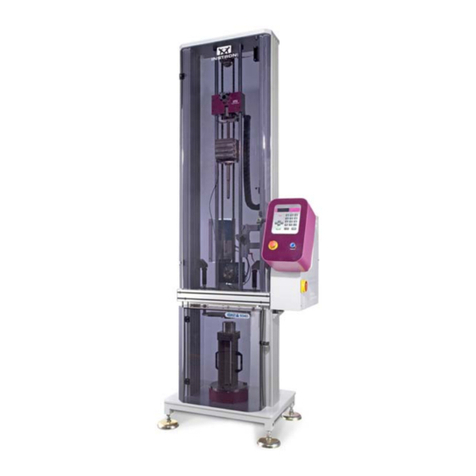
Instron
Instron CEAST 9340 Instructions for use and maintenance

Apposite
Apposite Netropy N91 quick start guide

Fluke
Fluke 718-100US user manual
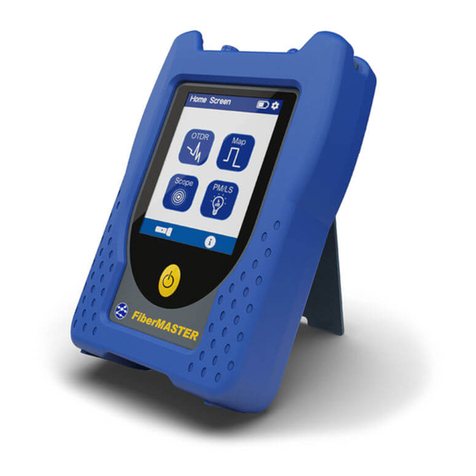
TREND NETWORKS
TREND NETWORKS FIBERMASTER Quick reference guide
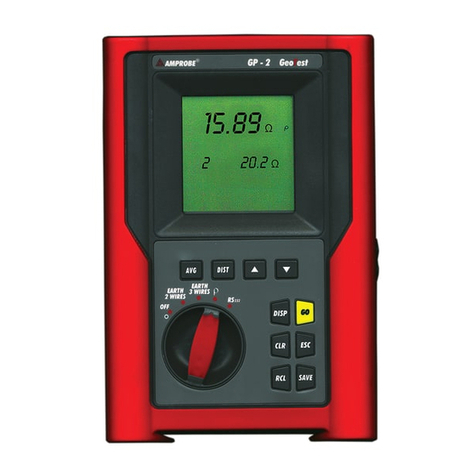
Amprobe
Amprobe GP-2 GeoTest instruction manual

Horiba Scientific
Horiba Scientific 6560S-10C instruction manual
